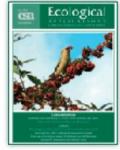Importance of Environmental and Spatial Gradients on Patterns and Consequences of Resource Selection
Strategies to conserve rare species require identifying resources that function as important habitat elements and that promote high demographic performance. Assessing the relative importance of resources, however, can be confounded by natural variation in resource availability and by the hierarchical spatial structure in which resources are organized. Because availability and relative importance of resources often vary across environmental and spatial gradients, we used gradients together with resource selection functions and variance decomposition to assess the relative importance of resources to nest site selection and reproductive performance of Ferruginous Pygmy-Owls (Glaucidium brasilianum). We measured habitat characteristics of 106 nests and paired available sites at five spatial scales across a 220-km gradient of precipitation and vegetation in northwest Mexico, in a region adjacent to the southwestern United States where pygmy-owls have declined to near extinction. Resources explained 76–85% of variation in nest site selection and 21–31% of variation in reproductive performance across all spatial scales combined. Although we found evidence of resource selection at each scale, the magnitude of selection and influence of resources on reproductive performance were greatest where availability of selected resources were low and where temperature extremes and predation risk likely increased the relative importance of these resources. At larger scales, geographic changes in resource use corresponded with changes in availability, whereas at smaller scales, resource use varied little despite changes in availability, suggesting higher specificity and importance of resources at smaller scales. At the smallest scale, owls selected nest cavities with smaller entrances, larger volume, greater height, and orientations that produced cooler microclimates in the hottest regions of the study area; these choices promoted higher reproductive performance. Cavity resources explained more variation in selection and reproductive performance than resources at larger scales, highlighting their importance as conservation targets. High correlation of resource characteristics among spatial scales, however, indicated that selection of resources at small scales depended on characteristics of resources at larger scales. Assessing how resource selection changes in response to underlying variation in resource availability can help prioritize resources most important for conservation and management.

